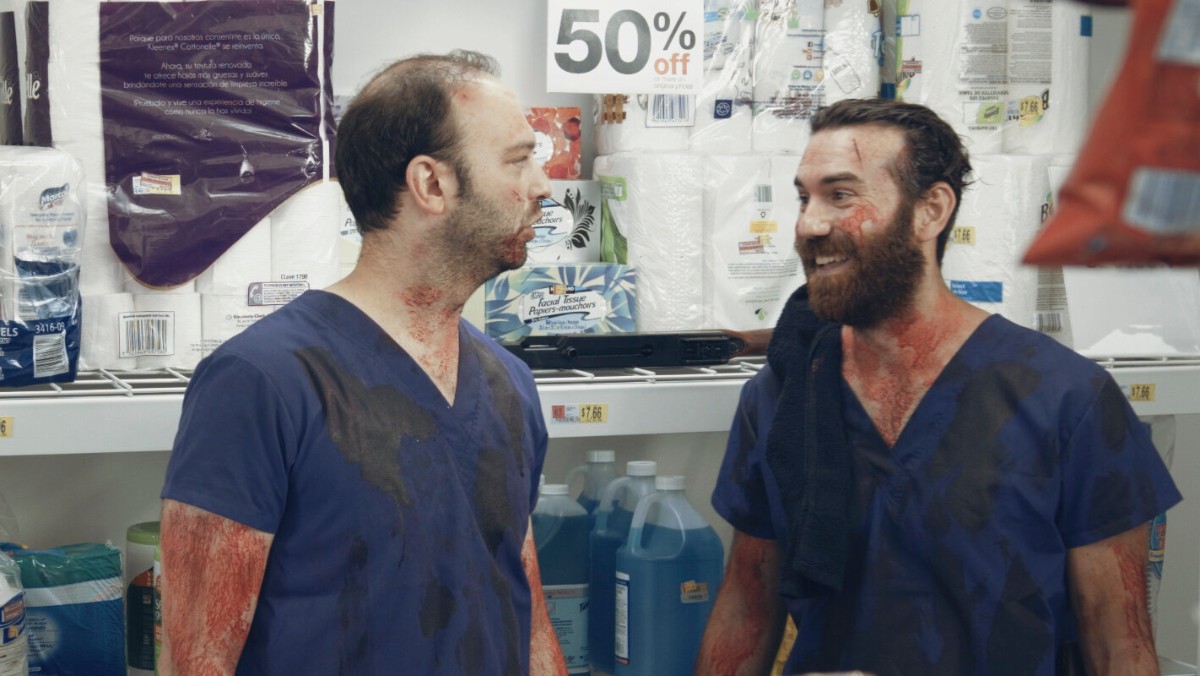
A Case Study
Narrative | Dramatic Features
Film Name: In Action
Genre: Action-Comedy
Date: January 2020
Director: Eric Silvera and Sean Kenealy
Producer: Alex Nordenson, Eric Silvera, and Sean Kenealy
Writer: Eric Silvera and Sean Kenealy
Cinematographer: Mateo Marquez
Production Company: ThinkPie, LLC
Budget: $30,000
Financing: Crowdfunding
Shooting Format: Digital, HD
Screening Format: Aspect Ratio 16:9
World Premiere: Premiered in March at the 2020 MidWest WeirdFest. Gravitas Ventures, A Red Arrow Company, acquired the film in January 2021 and it will be released on all major Streaming/Cable VOD Platforms beginning May 11th, 201.
Awards:
– Winner Best Film at MidWest Weirdfest (March 2020)
– Winner Audience Choice Award at The Art of Brooklyn Film Festival (June 2020)
– Winner Best Action Feature at Underground Indie Film Festival (June 2020)
– Nominee Outstanding Feature Film at High Peak Independent Film Festival, (Oct. 2020)
– Winner Best Action Comedy, Best Male Lead, and Best Editing at Rivercity Underground Film Festival (2020 Official Selection)
– Nominee Outstanding Feature Film at Central Florida Film Festival (Jan. 2021)
– Nominee Outstanding Feature Film, Best Editing, Best Male Lead (Eric Silvera & Sean Kenealy), at Southern Oasis Film Fest. (Feb 2021) Website: www.inactionmovie.com
indieactivity: Tell us about “who you are”?
Eric Silvera (ES): We are writers and friends who met in an MFA program at The City College of New York, bonding over our love of action movies. Forming a writing partnership, Sean pitched Eric a new idea: “An action movie with two people sitting in chairs talking to each other.” Eric wasn’t sure what that meant but was intrigued, and that idea spawned into In Action, their feature film debut.
Eric’s writing has appeared in multiple publications, won Slice Magazine’s “Bridging the Gap” award, and was shortlisted for Pop Monetral’s Lit POP prize. Sean’s plays have been staged across New York and Chicago at 13th Street Repertory, Gorilla Tango Theater, Brooklyn’s Impact Festival, and more.
Introduce your film?
Eric Silvera (ES): In Action is an over-the-top action-comedy about two bumbling screenwriters drafting the “next big action flick”, utterly oblivious to the insanity that awaits when the government intercepts their script, believing it to be a veritable terrorist plot.
While the film follows the tropes of the Action genre, there’s a bit twist… In Action has only two actors, it was filmed in two locations, and produced on a purposefully mega-low budget. By focusing on the core elements of the genre and using its filmmaking techniques, we created something with the style and feel of a big-budget action film for a totally new and fun movie experience. There are fist-fights, knife fights, foot chases, car chases, shootouts, explosions, one-liners & eccentric villains…but with only two people involved.
Our goal was to show that solid storytelling, even on a shoe-string budget, can keep an audience as entertained and excited as a $200MM summer blockbuster.
Tell us why you chose to write, produce, direct, shoot, cut/edit the movie? Was it financial, chance, or no-budget reason?
Eric Silvera (ES): We developed the In Action concept with the intention to both write and star in the film and have someone else direct us. While we formed a relationship with a director who had ideas that enhanced our script, over the course of pre-production we all realized that our visions didn’t necessarily align and parted ways. After this, it became clear that the two of us should direct the movie, as we had a specific vision of what we wanted In Action to be and could more effectively work with a crew to help translate it from the page to the screen.
Throughout this whole process, we worked very closely and collaboratively with our lead producer, Alex Nordenson. He was a voice of reason and a key partner in getting this movie off the ground; it’s hard to understate how helpful he was, especially when providing a counterpoint to certain ideas and making sure all angles to a major decision were explored before it was made. Additionally, he was our A.D. on-set for much of the production, keeping us on track throughout the shoot and also working closely with our D.P.
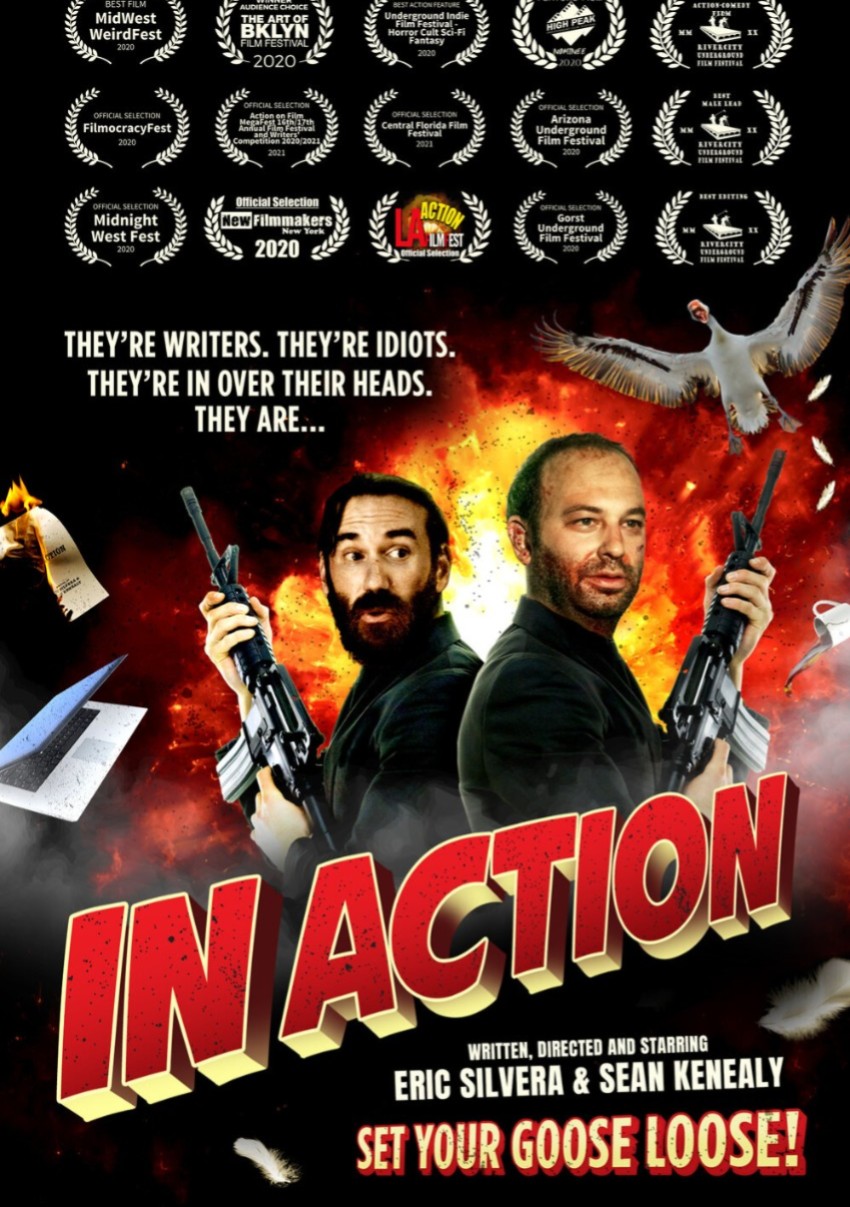
Introduce your crew?
Eric Silvera (ES): With all our crew, it was a blast to collaborate. Whether sitting in an editing room, giving notes on a score or taking time to talk with our makeup artists, it was always important for us that the crew was encouraged to use their own signature style.
Composer: Kevin Prockup
Cinematographer: Mateo Marquez
Editor: Billy Nawrocki
Sound Design: Christopher Woll
Hair and Makeup: Isata Allen
Makeup Special FX: Jared Balog
What are your personal experiences putting on all these hats/responsibilities (simultaneously)? Tell us about story, writing, and production?
Eric Silvera (ES): When you’re writing, you can dream up what you want – then in production, it’s time to get real and make your crazy ideas a reality (or at least try to).
One of our biggest challenges was bringing a car chase to life – without using an actual car, and having only the actors sitting in chairs. Ridiculous, we know…While we were writing the car chase scene we believed it could work with a talented crew in multiple departments, and that the scene would slowly come to life with each stage of production (over months).
We knew to pull this scene off we’d need interesting camera work, fast editing, a pulse-pounding score, intense sound design, and a commitment to play the scene as realistic as possible, even if the dialogue was jokey.
At first footage of the scene looked ridiculous (we also had to spend much of the production convincing our crew that this was an idea that could work. They were pretty confused whenever we described the idea to them…hahaha). However, after months of cutting and tinkering with our editor, working with our composer to develop the score, adding some light VFX, and lastly, having our sound designer round out scene with sound FX, it finally looked and felt like how we imagined while writing…even if it’s just two dudes sitting in chairs, hahaha.
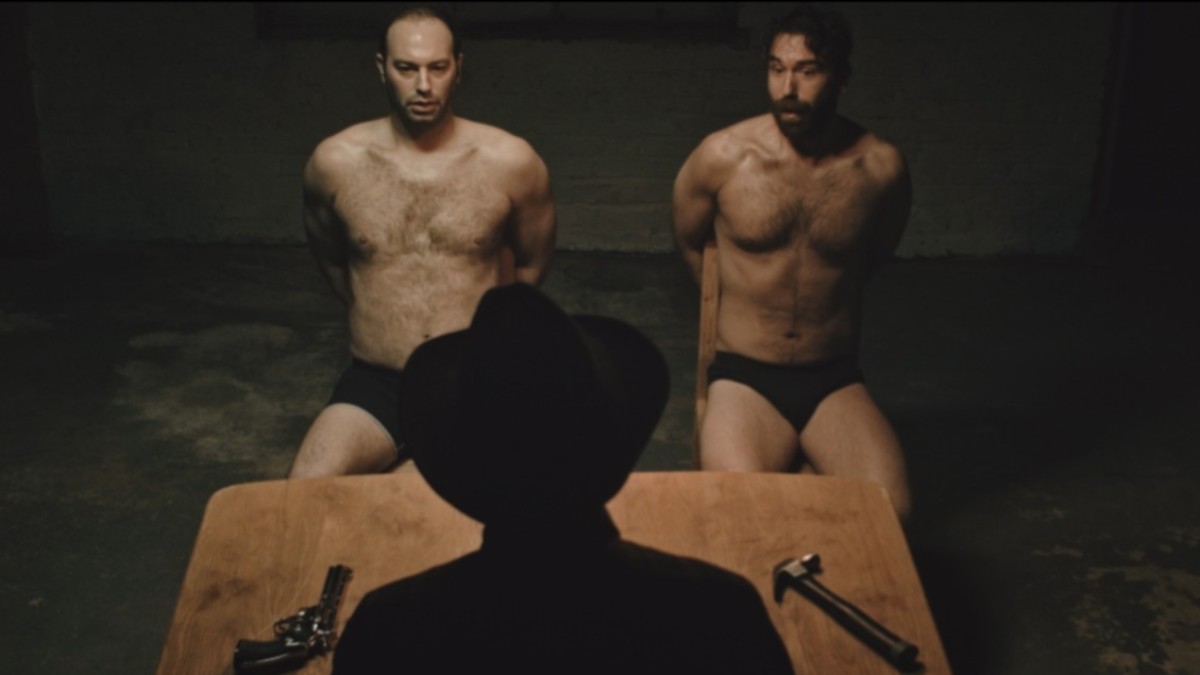
What is the source of the idea? How did the story develop from the idea? And how did the story evolve into a screenplay? Why do this story? Do you have a writing process?
ES: We wrote a few action screenplays before In Action. We’d send each other ridiculous emails back and forth with action movie plot ideas, and we joked about how if anyone ever saw our emails they could totally misinterpret them and think they were something other than a script ideas…So that’s how the story started.
Let’s talk pre-production: take us through a timeline of how you started and ended it.
ES: We shoot for 12 days over a year. Because our script takes place over multiple months, this process worked for us. We both work full-time day jobs, and have families, so spreading production out worked best for our lives.
What was your rehearsal process and period?
ES: Because our script is so dialogue heavy, we treated this like a theatre piece. We had multiple rehearsals before each shoot with an acting coach. Because we had a limited timeframe, and multiple jobs on set, it was essential we had our lines memorized and blocking in place so we were ready to go on shooting days.
You shot the film in days. How long were your days?
ES: 12 days – 10 hour days.
Did the tight shooting schedule make it harder or easier? How did it affect performances?
ES: Of course, it would have been great to have more time, but working under constraints can be a good thing. We often had to make decisions on the spot and take risks. Sure, that can be stressful, but it also gets the whole crew involved and produces energy that’s hard to mimic.
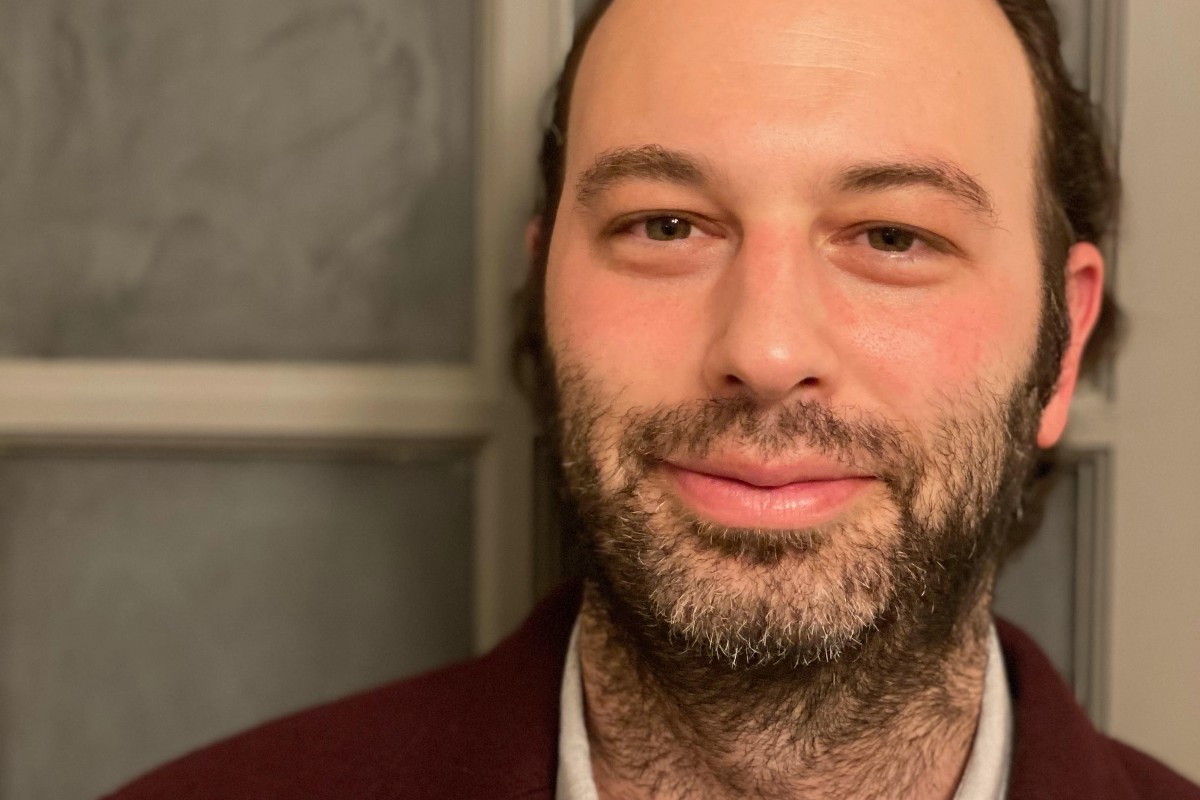
During the film production, what scene (that made the cut) was the hardest to shoot? And why?
ES: Car Chase – more info above on this scene.
What worked better in this latest production that mightn’t have worked so well in the last one you did?
ES: This is our first production.
What were the advantages and disadvantages in the way you worked?
ES: Because we both have day jobs in the non-film world (ad sales & higher education) that require us to manage teams/employees and multiple projects, our skill sets allowed us to translate this to running the set. We’ve learned how to communicate effectively, multi-task, and be nimble, improvise, and problem-solve when things aren’t going as planned. Crew members remarked it was the smoothest run set they’d been on.
The same advantage was also a slight disadvantage, ha. Since we have day jobs, post-production took much longer as we had to work with our team in chunks of time – either taking days off, late in the evening, weekends – which resulted in Post being spread over the course of a year-and-a-half, whereas it would have taken less time otherwise.
What was the experience like of working with a small shooting crew?
ES: Loved it.
The film looks stunning. How did you get such a good look when shooting so fast?
ES: Trusting our crew.
When did you form your production company – and what was the original motivation for its formation?
ES: We created an LLC in New York State.
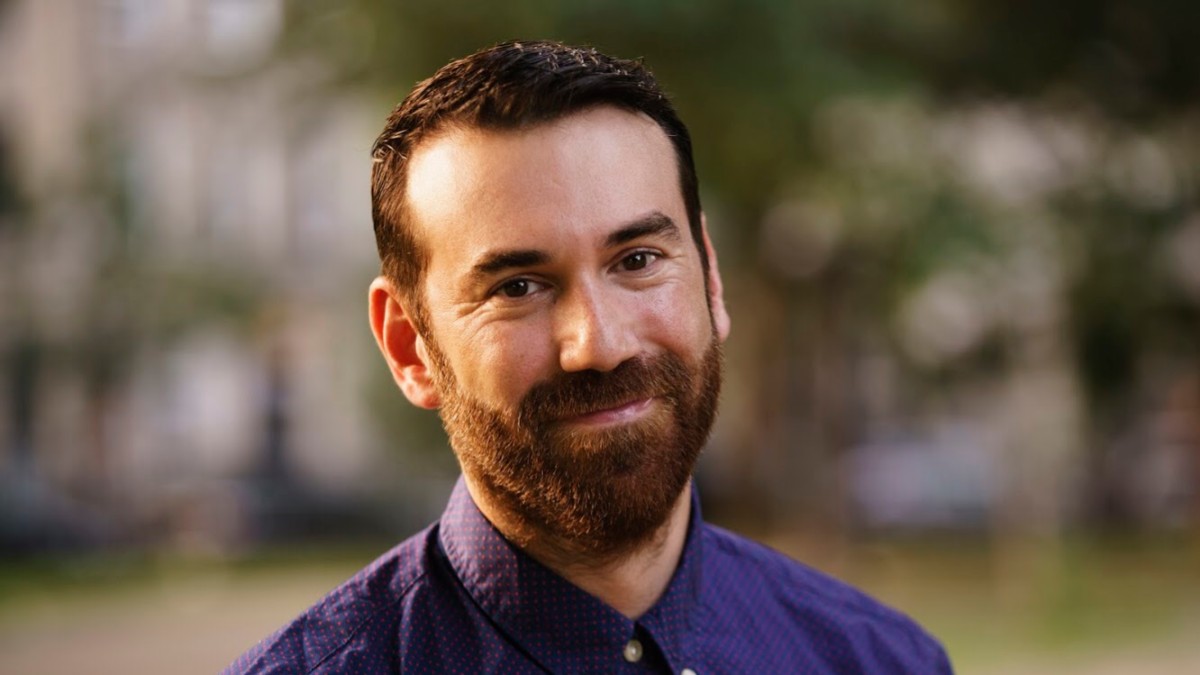
What was the first project out of the gate?
ES: In Action
What about independent filmmaking and the business do you still struggle with?
ES: Financing
Where do you think your strengths lie as a filmmaker?
ES: Collaboration
Let’s talk about finance. How did you finance the film?
ES: Crowdfunding
How much did you go over budget? How did you manage it?
ES: We stayed within budget
ow important is marketing? Talk about the festival tour? Do you think a project can make a dent without it nowadays?
ES: For us, festivals were the best way to gain exposure and get people to watch our film initially. We won the Audience Choice award at The Art of Brooklyn Festival in June 2020 and were lucky enough to have a sales agent reach out after that win. Through his representation, we received 5 distribution offers and were officially acquired by Gravitas Ventures in January 2021.
Because of Covid-19, our experience was mainly showing at virtual festivals. However, we were also lucky enough to play our first festival in March before the U.S. shutdown (literally 5 days before the shutdowns). We got to see the movie on the big screen, in Surround Sound, with an audience of strangers and other filmmakers, as intended, and that was an incredibly rewarding experience. It was also so great to see the work of other filmmakers and chat about each of our films after. The virtual experience was different, but could also be rewarding in its own right, especially with festivals that invested in making the digital experience fun and unique.
Overall, the festival route was the best way for us to get our movie out in the world, meet some other filmmakers, and we wouldn’t have the opportunities that we’ve received without it.
Tell us what you think of the Case Study for In Action What do you think of it? Let’s have your comments below and/or on Facebook or Instagram! Or join me on Twitter.
Follow filmmaker on Social Media
Website
IMDb
LinkedIn
Instagram
MORE STORIES FOR YOU









